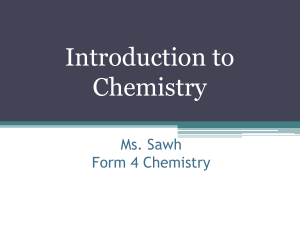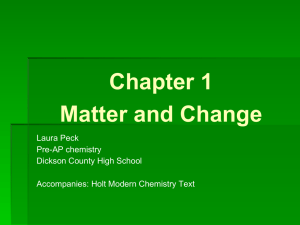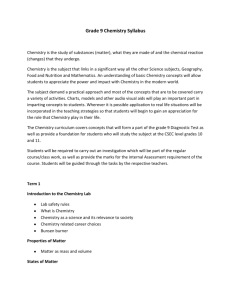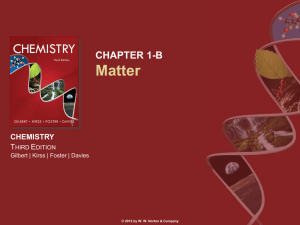File - Mrs. Sawh`s Cool Chemistry
advertisement
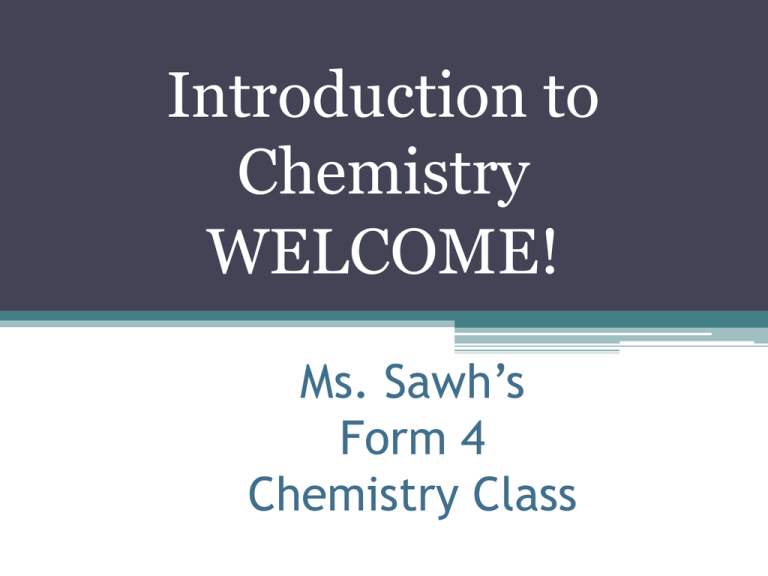
Introduction to Chemistry WELCOME! Ms. Sawh’s Form 4 Chemistry Class What you will need • • • • • • • Notebook: a new one/Form 3 notebook Textbook Lab book: purchase in school Goggles, lab coat, gloves (provided by school) Syllabus (available from Ms. Sawh) Past Papers (available in bookstores/school) Access to Computer and my website: www.sawhcoolchem.weebly.com • An email address • Folder pages/manila folders Structure of the Syllabus and CSEC Exam There are three major areas of Chemistry: • Physical Chemistry • Inorganic Chemistry • Organic Chemistry N.B. There is an Option Topic on Chemistry in Everyday Life which changes every two years. The CSEC Exam consists of three papers: • Paper I: 60 Multiple Choice Questions (30%) • Paper II: 6 Structured/Extended Answer Questions, all compulsory (50%) • Paper III: SBA (20%) School Based Assessment (SBA) You will be assessed in the following practical skills in Form 4 and Form 5: • Manipulation/Measurement (M/M) • Observations/Recording/Reporting (O/R/R) • Analysis and Interpretation (A/I) • Planning and Designing (P/D) All these skills will be assessed by your teacher (at least twice) and written up using the proper format in your lab books. An average of the marks awarded will be calculated and submitted to CXC out of a total of 10 marks for each skill. So SBA mark will be out of a total of 80 marks. Chemistry What do you think the study of Chemistry is about? Why are you studying Chemistry? Do you think Chemistry has any relevance to your everyday life? Why? How is Chemistry different to any other science e.g. Biology, Physics? Definition of Chemistry •Chemistry is the study of matter and the behaviour of particles in matter. •Anything that has a mass and a volume Close up view of atoms and their behavior •Changing from one state of matter to another is a Physical Change, e.g. melting Give another example. •If a new substance is formed it is a Chemical Change, e.g. Give another example. Images are from http://www.chem4kids.com Kinetic Theory of Matter (Particulate Nature of Matter) All Matter is made up of particles • Name these particles. • How do we know these particles exist? • What evidence do we have that proves matter is made up of particles? Processes that prove particles exist in matter The particles that exist in matter are: atoms, molecules and ions. The evidence that proves these particles exist are: • Diffusion • Osmosis • Brownian Motion • Write a definition of each and give examples. Pure and Impure Matter Matter can be pure and impure. How can we tell if a substance is pure? Can you name any pure substances? What are some impure substances? Pure substances • Atoms • Elements • Molecules • Compounds Can you write definitions for these pure substances and give examples? • Smallest indivisible particles making up elements. •The building blocks of Matter • Consists of Protons (+), Electrons (-), and Neutrons (0). • Consists of only one kind of atom, • Cannot be broken down into a simpler type of substance by either physical or chemical means • Can exist as either atoms or molecules. •Give examples. Images are from http://www.chem4kids.com • A molecule consists of two or more atoms of the same element, or different elements, that are chemically bound together. Give examples. • Atoms of two or more different elements bound together. • Can be separated into elements chemically, but not physically. Give examples. • Solutions are groups of molecules that are mixed up in a completely even distribution. •They can be homogeneous or heterogeneous. • Uniform Distribution. • Example: Sugar and Water Images are from http://www.chem4kids.com To make a solution: •The substance to be dissolved. •The one doing the dissolving. • Particle sizes are in between the size of particles found in solutions and suspensions . • Can be mixed and remain evenly distributed without settling out. • They are substances (compounds,elements) held together by physical forces, not chemical. • Can be separated physically. • Solutions are also mixtures, but can be heterogeneous. • The substances are not uniformly mixed. • Example: Sand in a glass of water. Images are from http://www.chem4kids.com • Are heterogeneous mixtures consisting of parts that are visible to the naked eye. • Substances will settle over time. Example: the ingredients in salad dressing Matter Pure Substances Mixtures Homogeneous Colloids Solution Solvent Solution Heterogeneous Suspensions Element Molecule Compounds Questions • How is a mixture different to a compound? • How is a compound different to a molecule? • How is an atom different to an element? • Is a solution a pure substance?
